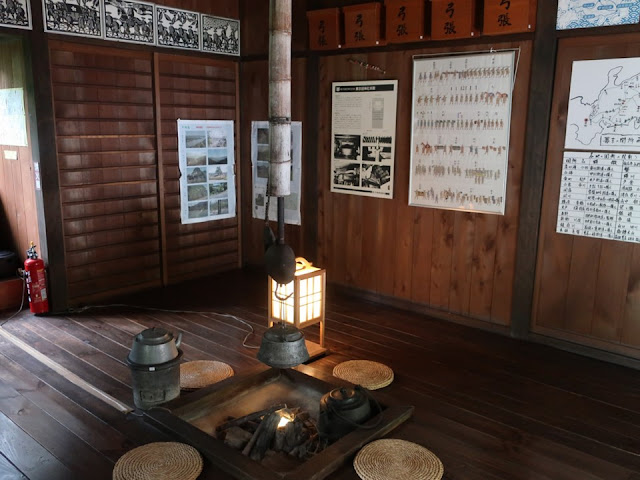There were checkpoints at major highways until the Edo period (1603~1868). The ex-checkpoint was rebuilt in 1976 due to strong requests of residents; it was 106 years later after the checkpoint was abolished. The building is smaller than it was, however, we can imagine the checkpoint. It is the pride of local people, isn’t it?
The checkpoint was built to control shipping
of lumbers (the area is a production center) while Toyotomi Hideyoshi ruled. In
the following Edo period, the checkpoint controlled the traffic of women,
goods and so on. It worked as a sub-checkpoint of Fukushima checkpoint
which was around 30km south of Niekawa. Btw, Niekawa is an entrance of Kiso
area which had eleven post-towns
in the Edo period.
住民の粘り強い活動で廃関から106年後の1976年に復元されました。規模は大幅に縮小されていますが、関所のイメージを感じさせる施設です。住民のみなさんの誇りですね。
木曽十一宿の北の入口にあたり、関所は秀吉の時代に木曽材木の持ち出しの監視のため設置されました。関ケ原の戦いの後、福島関所が設置されるとその副関として、女改めを中心に人と物の通行に目を光らせたということです。
There are five rooms in it. The room above
is a living room for guard officers.
5部屋が作られています。上は番士の生活の間です。
Officers permitted travelers to pass the checkpoint at the room above. Weapons are exhibited.
通行の可否を決定した上番所には武器が展示されています。
The photo above shows the guest room, in which a daimyo lord or a noble rested. Even officers couldn’t enter.
座敷は上段の間になっています。大名や公家の休憩所で、役人も立ち入れなかったとのこと。
Passports and so on are exhibited in the room above. The interesting thing is the love letter from a famous noble (Iwakura Tomomi) to the daughter of the innkeeper. He wrote a poem on it; it was really a noble! I wonder how many love letters he wrote during his trip.
この部屋では、通行手形などが展示されています。ユニークなのは岩倉具視の恋文のコピー。宿の女性を見初めて、匿名で手紙を書きました。和歌を交えた公家らしい手紙です。あちこちでちょっかいを出しているのですね。信濃にいる間(軽井沢を発つまで)に返事を寄越せということで、娘の父・綿屋の主は先約済みと丁寧に返事を出したそうです。
There were five kinds of passport at least for ladies; for a monk, a girl and so on. The dark room on the left is a checking room dedicated to women.
女性の手形は尼など五種類以上ありました。左奥の暗い部屋が女改めの部屋として設定されています。
Official website: https://www.city.shiojiri.lg.jp/soshiki/75/3813.html (in Japanese), accessed in January, 2024
Reference:
The sole existing checkpoint、現存する唯一の関所: Arai checkpoint museum、新居関所史料館
The restored checkpoint in full-scale、完全に再建した関所: Hakone Sekisho check point & Hakone Sekisho Exhibition Hall 箱根関所と箱根関所資料館
Niekawa post-town、贄川宿
There is a old residence of Fukazawa, although the post-town was suffered from big fires for three times after the Edo period. I’m not sure whether someone lives there or not.
明治以降三度の大火に見舞われた宿場ですが、深澤家住宅(非公開)が残っています。外から見ると障子はかなり傷んでいました。
There is a watering-place at the opposite of Fukazawa residence. A god is enshrined there, and there are two shrines (Tsushima and Akiba) beside the watering-place (there are many deities in Japan). A local said that the water is nice.
深澤家住宅の対面にある水場には神棚があり、隣には津島神社と秋葉神社がありました。地元の方が、よい水が出るとおっしゃっていました。
Niekawa post-town in the late 19th century. It is on the hill; maybe in order to prevent from flood. Nakasendo highway was wide and well maintained.
江戸末期から明治初期の贄川宿です。洪水を避けてか、高台にあります。中山道もよく整備され、広い道です。(贄川関所の展示品)
Lacquer town: Kiso Hirasawa、うるしの里・木曽平沢
You find Hirasawa town if you go south along Nakasendou. Lacquerware stores and workshops stand side by side. The town is designated as “Preservation Districts for Groups of Traditional Buildings” by the government. The highway curves along with the river. Therefore, buildings face the road like steps.
中山道を南に進むと、漆屋さんが軒を連ねる平沢に出ます。重要伝統的建造物群保存地区(重伝建)に指定されている美しい街です。奈良井川に沿って湾曲する街道に対し、家々が階段状(?)にせり出しています。
There is a craft museum of Kiso beside the route 19. The 1st floor has a shop space of lacquerware and so on. The 2nd floor introduces craftsmen and technology of lacquering; it is also a shop.
国道沿いの「道の駅 木曽ならかわ」に「木曽くらしの工芸館」があります。一階が工芸品などの売り場、二階が漆塗りの技術紹介や製品の展示販売です。職人さんたちの様子もわかって楽しいです。
Official
website: https://www.kiso.or.jp/ (in
Japanese), accessed in January, 2024
Visited in July, 2023
Previous post (museum near Nakasendou highway): Motoseba
history museum、本洗馬歴史の里資料館
Next post (Post-town on Nakasendou highway in the same prefecture): Narakawa, Historical and Folkloric Museum、楢川歴史民俗資料館















Comments
Post a Comment